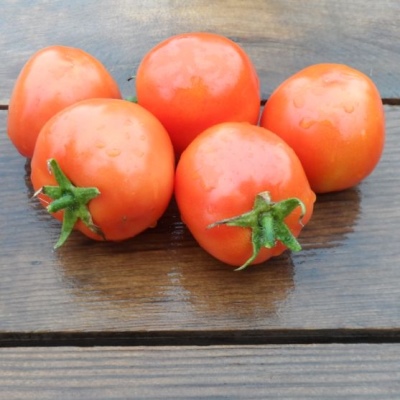
- Authors: Siberian selection
- Category: grade
- Growth type: determinant
- Appointment: fresh consumption, for pickling and preserving
- Ripening period: ultra early
- Ripening time, days: 80-87
- Growing conditions: for open ground
- Bush size: undersized
- Bush height, cm: 35-40
- Ripe fruit color: Red
For summer residents and farmers from regions with a temperate and northern climate, it is quite difficult to choose varieties of tomatoes for growing that will quickly adapt to local conditions and bring high yields. However, they do exist. Among these are Zhenechka, an ultra-early tomato variety.
Breeding history
The culture of Zhenechka with a long history is a gift for the risky farming zones of Siberia and the Urals. A vegetable crop was bred by domestic breeders from Siberia more than 20 years ago. The variety is recommended for cultivation in almost all regions, including areas with short summers.
Description of the variety
Tomato Zhenechka is a low-growing bush of a determinant type, growing up to 35-40 cm. The plant's stems are thick and powerful. The bush is characterized by moderate foliage and a simple type of inflorescences formed after 5-6 leaves. The branches of the bushes are spreading, so there are a lot of fruits on them. Fruits are formed by tassels, on average, 5-6 tomatoes in each. This type of tomato adapts perfectly to open ground. Among the recommendations of farmers, it is compulsory to tie bushes to supports. The plant does not require grazing.
The main qualities of the fruit
The tomato has a rounded shape with barely noticeable ribbing. The color of the ripe fruit is classic red, and at first they are light green. The average weight of the berries is 100 grams, but sometimes tomatoes grow up to 150 g. The peel of the fruit is strong, which ensures good transportability and prevents cracking. The keeping quality of the variety is long, the main thing is to comply with the storage conditions of the crop.
Taste characteristics
The taste of Zhenechka's fruits, characteristic of tomatoes, is sweet, with a noticeable sourness. The flesh of the berry is fleshy, moderately dense, red in color, rather juicy and with a small content of seeds. The variety is suitable for eating fresh tomatoes, as well as for canning, making juices, sauces and others.
Ripening and fruiting
Zhenechka is an ultra-early ripening variety. Less than 3 months (80-87 days) pass from the appearance of the first shoots to the fruiting phase. Ripening occurs amicably, almost simultaneously. When ripe, the berries hold tightly to the branches, without crumbling.
Yield
Despite the dwarf type of crop, the variety has a high yield. Subject to all the rules of agricultural technology, up to 4 kg of tomatoes can be harvested from 1 bush per season. Harvesting may take until the first frost, it all depends on the region of growth. The active harvesting phase is in July-August. You can harvest with individual berries or whole brushes.
The timing of planting seedlings and planting in the ground
Sowing seeds for seedlings is recommended 55-60 days earlier before planting in open ground. Typically, this is the period from early March to the first week of April. Sowing dates depend on the climatic conditions of the region: southern zone (early March), temperate (late March) or northern zone (early April). The seed must be disinfected and tested for germination. For healthy growth of bushes, it is recommended to use loose and light soil. After planting, create a greenhouse effect using glass or polyethylene to accelerate seed germination. The bush growing room should be well lit and warm.With the appearance of 3 true leaves, a dive is performed. 2 weeks before planting in open ground, it is recommended to harden the bushes so that they can more easily endure the stress from the transplant.
It is planted in open ground from May to June. The air should warm up well, and the night frosts should be left behind.

Growing tomato seedlings is an extremely important process, because it largely depends on whether the gardener will be able to harvest at all. All aspects must be taken into account, from seedbed preparation to planting in the ground.
Landing scheme
The compactness and diminutiveness of the bushes allows their dense planting - 3-5 plants per 1 m2. The optimal planting pattern is 60x70 cm.

Growing and care
The culture is grown by seedling method. The site is cleared of weeds, dug up, which improves air permeability, and complex fertilizers are also applied. Crop care consists of the following procedures: watering, the formation of bushes in some cases, the obligatory garter, fertilizing at the root, loosening the soil and preventing diseases.




A plant needs different micronutrients at each stage of growth. All fertilizers can be divided into two groups: mineral and organic. Folk remedies are often used: iodine, yeast, bird droppings, eggshells.
It is important to observe the rate and period of feeding. This also applies to folk remedies and organic fertilizers.
Disease and pest resistance
Resistance to many viruses and diseases, which often suffer from nightshade crops, the variety is high. Due to their early maturity, tomatoes do not suffer from late blight.


Resistant to adverse weather conditions
The culture is frost-resistant, and also develops well and bears fruit in extreme heat.
Growing regions
The variety can be grown in any climatic zone of the Russian Federation, Ukraine, Moldova. The main thing is to follow the basic rules of care.
Review overview
The variety Zhenechka is loved by both summer residents and farmers who grow tomatoes for commercial purposes. It is characterized as high-yielding, unpretentious, very tasty, and versatile, which is especially appreciated in cooking and canning. In addition, the bushes are compact, which allows them to be planted in small areas.

























































































